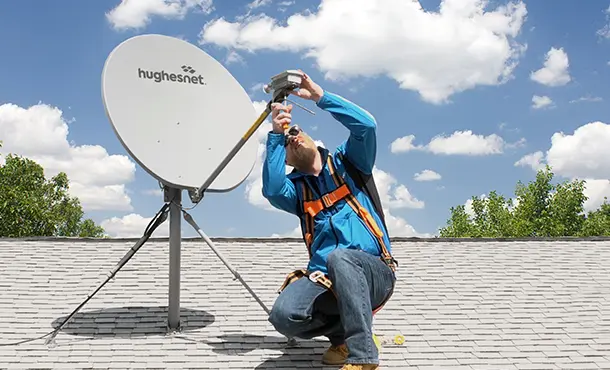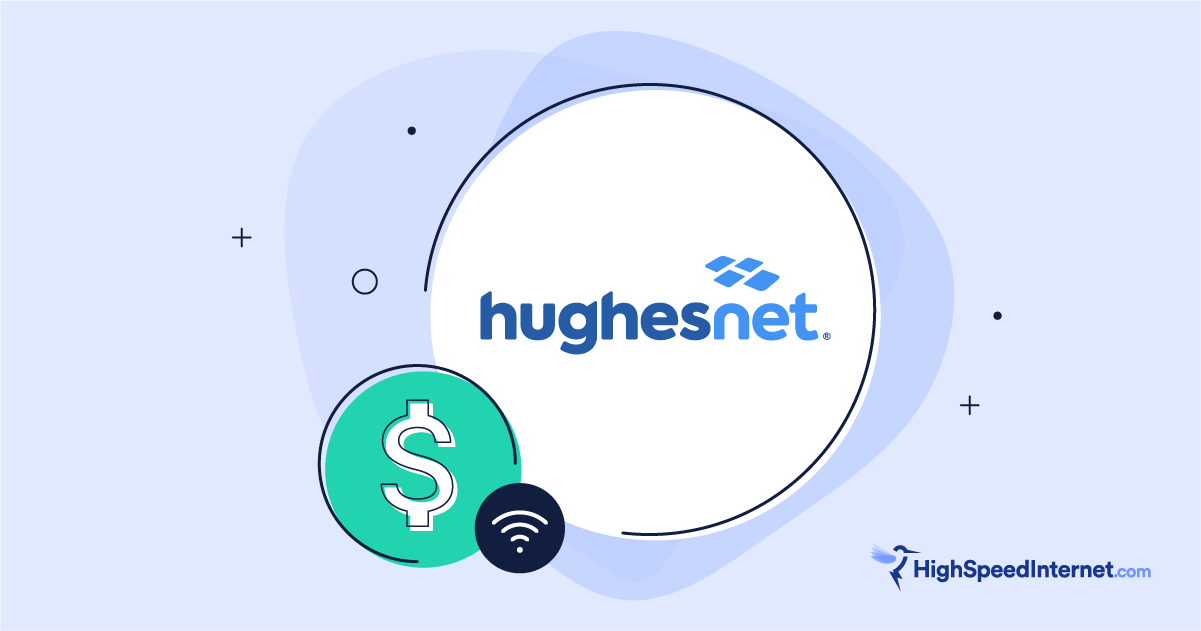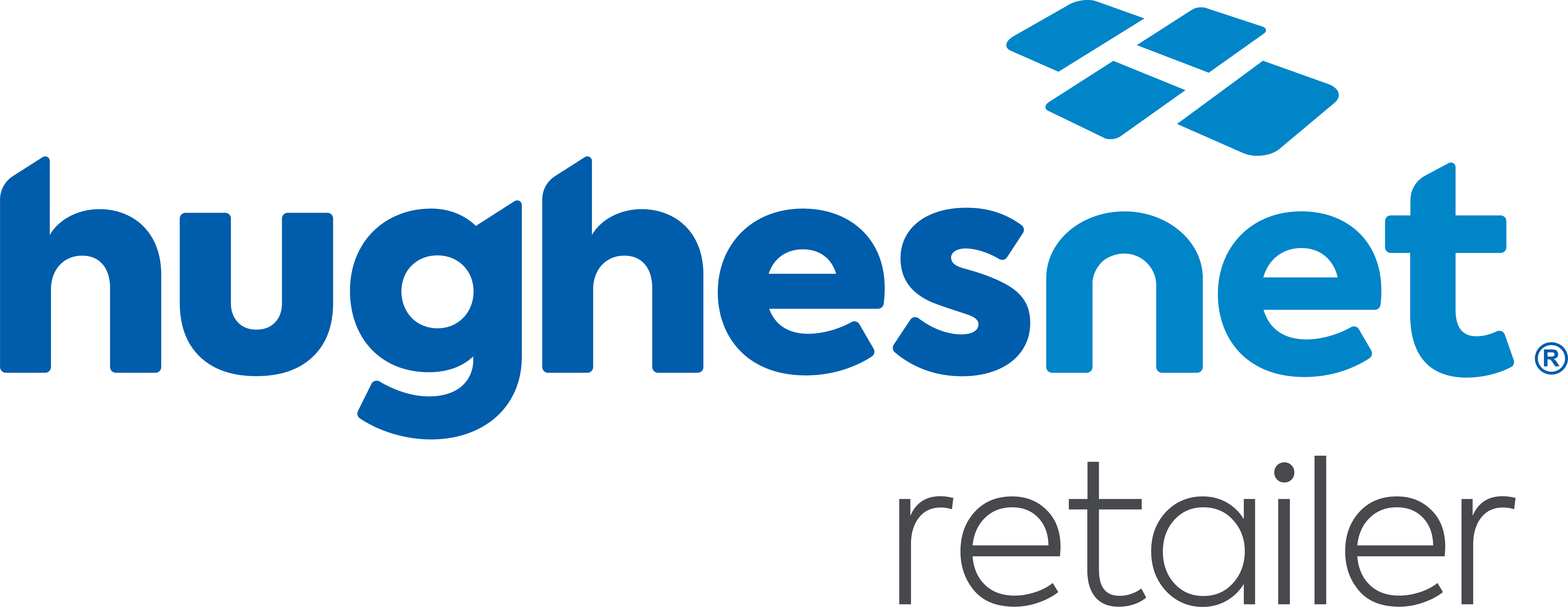Article-At-A-Glance
- Hughesnet offers near-universal coverage in rural areas where cellular internet often has limited to no signal strength
- Recent satellite upgrades have boosted Hughesnet speeds up to 100Mbps, making it competitive with many cellular options
- Unlike cellular plans that throttle speeds after reaching data limits, Hughesnet continues providing usable internet at reduced speeds
- Rural homeowners face significantly fewer installation and reliability issues with satellite versus depending on distant cell towers
- While Hughesnet requires professional installation, its consistent performance in remote locations outweighs the initial setup investment
Finding reliable internet in rural America isn’t just challenging—it’s often a battle between compromising on speed or overpaying for spotty service. If you’ve been weighing your options between Hughesnet satellite internet and cellular providers, you’re about to discover why satellite might be your best bet for consistent connectivity regardless of your location.
Hughesnet has dramatically improved its service offerings in recent years, making it increasingly competitive with cellular internet options. With speeds now reaching up to 100Mbps through their advanced satellite network, Hughesnet delivers reliable internet access to homes where cellular coverage maps show nothing but blank spaces. Whether you’re working remotely, streaming entertainment, or simply trying to stay connected, understanding these differences can save you significant frustration.
Quick Decision Guide: Satellite vs Cellular Internet
When comparing Hughesnet satellite internet to cellular options, consider your specific location first. Cellular internet requires proximity to towers and can be affected by terrain and obstacles, while Hughesnet provides consistent coverage virtually anywhere with a clear view of the southern sky. If you live more than a few miles from the nearest cell tower, Hughesnet will likely provide more reliable performance without the frustration of fluctuating speeds throughout the day.
Weather impacts both technologies differently—cellular signals can be degraded by heavy rain or snow, while satellite connections may experience brief interruptions during severe storms. However, Hughesnet’s new equipment has significantly improved weather resilience compared to older satellite systems. Price structures also differ fundamentally, with Hughesnet offering predictable monthly costs versus cellular plans that often include complex data caps and potential overage charges.
Why Rural Internet Access Still Remains a Challenge

“Rural Internet Access – Wathen Insurance” from www.watheninsurance.net and used with no modifications.
Despite billions in government funding and promises of universal broadband access, approximately 42 million Americans still lack reliable high-speed internet. This persistent digital divide creates significant disadvantages for rural communities in education, healthcare access, economic opportunity, and quality of life. The fundamental challenge remains one of infrastructure economics—installing fiber or cable networks in sparsely populated areas simply doesn’t provide the return on investment that telecommunications companies require.
The Digital Divide: Where Good Internet Still Doesn’t Reach
The geography of internet inequality follows predictable patterns across America. Urban and suburban areas enjoy multiple high-speed options at competitive prices, while just miles away, rural communities face limited or non-existent service. This disparity creates a modern form of isolation that impacts everything from property values to education outcomes. When traditional broadband providers calculate the cost of running cable or fiber per household, rural areas simply don’t meet the profitability threshold, leaving residents with few options beyond satellite or cellular connections.
This connectivity gap has real consequences for rural communities. Students struggle to complete online assignments, telehealth appointments buffer endlessly, and remote work opportunities remain out of reach. Without reliable internet, rural economies fall further behind as businesses and younger residents relocate to better-connected areas. The pandemic only heightened these inequalities as society shifted to digital-first models for essential services.
Why Cellular Networks Fall Short in Remote Areas
Cellular internet might seem like the perfect solution for rural connectivity—after all, it works wirelessly and doesn’t require expensive infrastructure to each home. Unfortunately, the reality in truly rural areas proves far more complicated. Cell towers have limited range (typically 2-10 miles depending on terrain), and companies prioritize placement in areas with the highest population density for maximum return on investment.
Even when a signal does reach your location, it’s often significantly weaker than advertised. Hills, trees, buildings, and even weather conditions can degrade cellular signals, causing frustrating performance fluctuations throughout the day. Additionally, cellular networks face congestion issues during peak usage hours as everyone in an area shares the same tower’s bandwidth. This results in unpredictable performance exactly when you need reliability most—evenings and weekends. For an alternative, consider exploring Hughesnet satellite internet, which can offer more consistent connectivity.
“When we tried cellular internet at our farm, we’d get decent speeds at 3AM, but during normal working hours or evenings when the kids needed to do homework, speeds would drop to unusable levels. Our Hughesnet connection might not be the fastest, but at least it’s consistent regardless of what time it is.” – Sarah M., Rural Wisconsin
The Cost of Limited Options for Rural Homeowners
Rural internet customers often pay significantly more for lower quality service simply because competition doesn’t exist in their area. When comparing internet options, many rural homeowners find themselves forced to choose between equally unappealing compromises: high-latency satellite, unreliable cellular, or antiquated DSL connections. This lack of choice enables providers to charge premium prices for what would be considered substandard service in urban markets.
Beyond the direct monthly costs, unreliable internet creates hidden expenses for rural households. From missed work opportunities to increased fuel costs from driving to access public WiFi, the true price of poor connectivity extends far beyond the bill itself. Many families resort to maintaining multiple internet services—perhaps satellite for home use and cellular as backup—effectively doubling their connectivity expenses compared to urban counterparts who pay for a single reliable connection.
How Hughesnet Satellite Internet Actually Works

“Whole Home Wi-Fi | Hughesnet®” from www.hughesnet.com and used with no modifications.
Understanding the technology behind satellite internet helps explain both its advantages and limitations compared to cellular options. Unlike cellular internet that relies on ground-based towers, Hughesnet’s system utilizes satellites orbiting 22,236 miles above Earth in geostationary orbit. This fundamental difference in transmission method creates near-universal coverage regardless of terrain or distance from population centers—a crucial advantage for truly remote locations.
The Technology Behind Satellite Internet Connections
When you browse the web or stream content through Hughesnet, your request travels from your home equipment to the satellite and then to a ground station connected to the internet backbone. The response follows the reverse path back to your device. This journey happens at the speed of light but covers a tremendous distance, creating the latency (delay) that satellite internet is known for. While this creates a noticeable delay when loading web pages or during video calls, it doesn’t significantly impact streaming or download speeds once connections are established.
Hughesnet’s New Jupiter 3 Satellite: What It Means for Speed
The launch of Hughesnet’s Jupiter 3 satellite represents a game-changing advancement in rural internet capabilities. This next-generation satellite delivers significantly more capacity and higher speeds than previous systems, enabling Hughesnet to offer plans with speeds up to 100Mbps in select areas—a dramatic improvement over their previous 25Mbps maximum. This technological leap puts Hughesnet’s performance on par with many cellular internet options while maintaining the coverage advantages inherent to satellite technology.
Jupiter 3 introduces advanced spot beam technology that concentrates signal strength more effectively, providing better performance even during peak usage hours. The satellite’s increased throughput capacity means less congestion and more consistent speeds regardless of how many subscribers are online simultaneously. This reliability advantage becomes particularly important during evenings and weekends when cellular networks often experience significant slowdowns due to increased usage across their limited tower infrastructure.
Typical Installation Process and Equipment Needed
Hughesnet installation requires professional setup, typically taking 2-3 hours to complete. The technician will mount a satellite dish with a clear view of the southern sky, run cabling to your home, and set up the modem and WiFi router inside. Unlike cellular options that may work with existing equipment, Hughesnet’s specialized hardware ensures optimal signal reception and processing specifically designed for satellite transmission.
The standard installation includes a 2-foot diameter dish antenna, transmitter/receiver, and an indoor modem/router combination. While the professional installation represents an additional upfront cost compared to self-installed cellular options, it eliminates the frustration of troubleshooting signal issues that often plague DIY cellular internet setups in rural areas. Most Hughesnet installation fees range from $99-$199, though promotions frequently offer reduced or waived installation costs for new customers who commit to a 24-month service agreement.
5 Key Advantages of Hughesnet Over Cellular Internet

“Low-Income Internet through Hughesnet …” from www.highspeedinternet.com and used with no modifications.
When evaluating internet options for rural locations, understanding the fundamental differences between satellite and cellular technologies reveals why Hughesnet often provides a superior experience for remote households. Beyond simple availability, Hughesnet offers several structural advantages that address the common pain points rural internet users experience with cellular connections.
1. Near-Universal Coverage Regardless of Location
Hughesnet’s satellite technology delivers consistent service quality virtually anywhere in the continental United States with a clear view of the southern sky. This coverage uniformity represents a critical advantage over cellular internet, which depends entirely on proximity to towers and local topography. While cellular coverage maps may show theoretical service at your address, actual performance often differs dramatically from advertised speeds due to distance, obstacles, and signal interference.
For homes located in valleys, heavily wooded areas, or simply too far from the nearest cell tower, Hughesnet provides reliable connectivity where cellular signals struggle to reach. This coverage guarantee becomes particularly valuable for remote properties, farms, or homes in mountainous regions where cellular infrastructure remains limited or non-existent. The ability to obtain consistent internet regardless of terrain represents perhaps the most compelling reason many rural customers choose Hughesnet over cellular alternatives.
2. Consistent Speed Without Tower Congestion Issues
Cellular internet performance fluctuates significantly throughout the day as more users connect to the same tower, sharing limited bandwidth. During peak usage hours—typically evenings between 7-11pm—cellular speeds often drop to a fraction of advertised rates as network congestion intensifies. This inconsistency makes cellular internet particularly frustrating for streaming, video conferencing, or online gaming when reliability matters most.
Hughesnet’s satellite technology operates independently of ground-based infrastructure congestion, delivering more consistent performance regardless of how many neighbors are online. While Hughesnet does manage network capacity through data allowances, the actual transmission speed remains stable throughout the day rather than varying wildly based on tower traffic. This predictability allows rural households to plan their internet usage more effectively without constantly checking speed tests or scheduling important online activities during off-peak hours.
3. Dedicated Data Plans vs. Throttled Cellular Options
“Truly unlimited data” in cellular marketing often conceals significant fine print. Most “unlimited” cellular plans throttle speeds dramatically after reaching priority data thresholds—typically between 15-100GB—often reducing connections to barely usable speeds of 128Kbps-3Mbps for the remainder of the billing cycle.
Hughesnet takes a more transparent approach to data management with clearly defined data allowances and predictable performance when those limits are reached. Rather than throttling to unusably slow speeds, Hughesnet reduces speed to 1-3Mbps after exceeding your data allowance—still sufficient for basic browsing, email, and even standard definition streaming. This approach ensures you maintain functional internet throughout the month rather than facing the complete service degradation common with cellular plans.
Additionally, Hughesnet offers the unique Bonus Zone benefit, providing 50GB of extra data during off-peak hours (2am-8am) that doesn’t count against your regular allowance. This feature allows users to schedule large downloads, system updates, or backup processes overnight without impacting their daytime data availability. No cellular providers offer comparable features for managing data consumption effectively across different times of day.
Perhaps most importantly, Hughesnet’s data management approach allows continued access to all online services even after exceeding allowances. Many cellular providers implement not just speed throttling but also restrict video quality, hotspot functionality, and certain application access once users exceed priority data thresholds—limitations that don’t exist with Hughesnet’s more straightforward approach.
4. Fixed Monthly Costs Without Surprise Overage Charges
Hughesnet’s pricing structure eliminates the “bill shock” that frequently accompanies cellular internet services. With clearly defined monthly rates and no overage charges, Hughesnet customers enjoy predictable billing regardless of how much data they use. When you exceed your data allowance, your speed reduces temporarily, but your bill remains unchanged—a significant advantage over cellular providers that may charge $10-15 per additional gigabyte or require mid-cycle plan upgrades to restore usable speeds.
This billing certainty proves particularly valuable for households managing tight budgets, as unexpected overage charges from cellular providers can quickly add hundreds of dollars to monthly expenses. For families with children, gamers, or remote workers who may occasionally exceed typical usage patterns, Hughesnet’s approach provides peace of mind that internet costs remain fixed regardless of consumption spikes. While higher data allowance plans naturally cost more initially, you’ll never face the surprise $300+ bills that commonly plague cellular internet users who inadvertently exceed their limits.
5. Multiple Device Connection Without Performance Loss
Modern households connect numerous devices simultaneously—from smartphones and computers to smart TVs, security systems, and IoT devices. Hughesnet’s network architecture efficiently handles multiple concurrent connections without the performance degradation often experienced with cellular hotspots or home internet solutions. This multi-device capability proves especially valuable for families or homes that serve as remote workspaces where several people need reliable connectivity simultaneously for different purposes.
Hughesnet’s Latest Speed and Plan Improvements
“Hughesnet Internet Plans and Deals …” from www.reviews.org and used with no modifications.
The satellite internet landscape has evolved dramatically in recent years, with Hughesnet making significant advancements that challenge outdated perceptions about satellite service quality. The introduction of the Jupiter 3 satellite has enabled Hughesnet to launch their Fusion plans, offering dramatically improved speeds and more generous data allowances than previous generations of satellite internet.
These technical improvements have fundamentally changed the competitive landscape between satellite and cellular options for rural customers. Where cellular once held a clear speed advantage, Hughesnet’s latest offerings provide comparable or superior performance in many scenarios while maintaining their coverage advantage in truly remote locations. For rural customers evaluating their options in 2023, these advancements make satellite a much more compelling choice than in previous years.
Current Download Speeds Up to 100Mbps
Hughesnet’s newest plans offer download speeds up to 100Mbps in many service areas—quadruple their previous maximum of 25Mbps. This dramatic speed increase enables smooth 4K video streaming, responsive video conferencing, and quick downloads of large files. The speed improvements particularly benefit households with multiple simultaneous users, as the higher bandwidth accommodates several devices accessing demanding applications without the buffering and latency issues that plagued earlier satellite internet generations.
Data Allowances and What Happens When You Exceed Them
Current Hughesnet plans offer data allowances ranging from 15GB to 200GB of priority data, with the most popular plans providing 100GB monthly. When customers exceed their data allowance, speeds reduce to 1-3Mbps for the remainder of the billing cycle—slower than full speed but still functional for basic internet tasks. This approach differs significantly from cellular throttling, which often reduces speeds to nearly unusable levels (128Kbps-512Kbps) after reaching data caps, effectively cutting off meaningful internet access until the next billing cycle begins.
Price Comparison: Hughesnet vs. Major Cellular Providers
Hughesnet plans typically range from $64.99 to $149.99 monthly for residential service, with the most popular 100GB plan priced at $109.99. This pricing structure generally aligns with or slightly exceeds comparable cellular internet options, with Verizon Home Internet starting at $80/month and T-Mobile Home Internet at $60/month. However, the direct price comparison doesn’t account for cellular availability limitations, potential equipment costs, and the significant advantage of Hughesnet’s true nationwide coverage regardless of proximity to towers.
When evaluating total cost of ownership, consider that cellular providers often require purchasing signal boosters ($200-500) to achieve usable signals in rural areas—additional equipment not factored into advertised monthly rates. Additionally, the consistent performance of Hughesnet versus the highly variable cellular experience in truly rural locations adds significant value beyond the simple monthly price comparison, particularly for those who depend on reliable internet for work, education, or healthcare needs.
Real-World Performance: What to Actually Expect from Hughesnet

“HUGHESNET HIGH SPEED INTERNET – Updated …” from m.yelp.com and used with no modifications.
Beyond marketing claims and technical specifications, rural internet customers need realistic performance expectations when choosing between satellite and cellular options. Hughesnet’s real-world performance depends significantly on your specific location, plan selection, and typical usage patterns, but certain consistent characteristics help predict your likely experience.
The most important performance consideration with satellite internet remains latency—the delay between requesting information and receiving it. While Hughesnet’s speeds have improved dramatically, the physics of transmitting data to and from satellites 22,000 miles in space creates inherent latency of approximately 600-800 milliseconds. This delay doesn’t significantly impact streaming or downloading once connections are established but does create noticeable hesitation when browsing websites or using real-time applications like video conferencing or online gaming.
Typical Download and Upload Speeds
Real-world testing shows Hughesnet customers typically experience 80-90% of advertised download speeds during normal conditions, with their 100Mbps plans consistently delivering 85-95Mbps during optimal conditions. Upload speeds remain considerably lower at 3-5Mbps across all plans—sufficient for video calls and basic file sharing but potentially limiting for content creators or those who frequently upload large files. This asymmetrical speed profile (faster downloads than uploads) aligns with most residential internet use patterns but differs from some cellular options that offer more balanced upload/download ratios.
Customer Satisfaction Metrics (47% Reliability Rating)
Independent surveys of Hughesnet customers reveal a mixed satisfaction picture that’s important to understand before committing. According to American Customer Satisfaction Index (ACSI) data, Hughesnet achieves a 47% reliability rating—lower than fiber or cable providers but slightly higher than most cellular internet options in rural areas. This middling satisfaction score primarily reflects the inherent limitations of satellite technology rather than service quality issues specific to Hughesnet.
Diving deeper into customer feedback reveals interesting patterns. Long-term customers who understand satellite internet’s limitations report higher satisfaction than those transitioning from urban broadband experiences. The most common complaints center around data caps and latency issues, while installation quality and customer service receive more positive ratings. Importantly, when comparing rural-specific ratings (rather than national averages that include urban users), Hughesnet consistently outperforms cellular alternatives for reliability in truly remote locations.
Making the Switch: How to Set Up Hughesnet Successfully

“Easy & Fast Satellite Internet Setup …” from www.youtube.com and used with no modifications.
Transitioning to Hughesnet from another internet provider requires careful planning to minimize downtime and ensure optimal performance. Begin by scheduling installation at least 2-3 weeks before canceling your existing service, as installation appointments may have limited availability in remote areas. Before installation day, identify potential mounting locations with clear southern sky visibility and ensure easy access to where you want the indoor equipment placed. Having your home network information ready (including WiFi names and passwords you want to use) will help streamline the setup process once your equipment is installed.
Professional vs. Self-Installation Options
Unlike most cellular internet options, Hughesnet requires professional installation due to the precision needed for satellite dish alignment and the specialized equipment involved. Standard installation costs range from $99-$199, though promotions frequently waive this fee for new customers signing 24-month agreements. The professional installation includes mounting the satellite dish, running cable to your home, setting up the modem/router, and confirming proper signal strength and network functionality before the technician leaves. This professional approach, while more expensive initially than self-installed cellular options, eliminates the frustrating signal hunting and equipment troubleshooting that often plagues DIY rural internet setups.
Current Promotions and Deals for New Customers
Hughesnet regularly offers promotional pricing for new customers, with current deals including $20/month discounts for the first six months of service, free standard installation (normally $99), and free equipment when signing a 24-month agreement. Additional seasonal promotions may include increased data allowances, gift cards valued at $50-$100, or bundled services with partners like DISH Network. These promotional offers typically require commitment to a 24-month service agreement, with early termination fees applying if service is canceled before the contract term ends. Unlike cellular providers that often require qualifying credit for their best promotions, Hughesnet offers consistent deals regardless of credit score, making it accessible to customers who might not qualify for premium cellular plans.
Final Verdict: Who Should Choose Hughesnet Over Cellular Internet

“Computer Royalty-Free Images …” from www.shutterstock.com and used with no modifications.
Hughesnet satellite internet represents the ideal solution for truly rural customers who prioritize reliability and availability over absolute speed. If you live more than 5 miles from the nearest cell tower, experience poor cellular reception at your property, or need guaranteed service regardless of local terrain challenges, Hughesnet provides substantial advantages over cellular alternatives. The technology particularly benefits rural professionals who work from home, families with multiple internet users, and households in areas where cellular infrastructure remains underdeveloped.
However, customers with reliable cellular coverage, particularly those with line-of-sight to 5G towers or access to T-Mobile or Verizon home internet services, may find those options provide better performance for lower monthly costs. Similarly, customers who primarily need internet for high-response activities like competitive online gaming will likely find cellular options with lower latency more suitable despite potential reliability challenges. Your specific location, usage patterns, and reliability requirements should ultimately drive the decision between satellite and cellular options rather than focusing exclusively on advertised speeds or monthly prices.
Frequently Asked Questions
Based on common questions from rural internet customers considering Hughesnet, here are straightforward answers to help you make an informed decision about whether satellite internet represents your best connectivity option.
Does Hughesnet require a phone line or existing internet connection?
No, Hughesnet operates completely independently of telephone lines or existing internet services. The satellite system provides a standalone connection requiring only electricity and a clear view of the southern sky. This independence from ground-based infrastructure represents one of Hughesnet’s primary advantages for remote locations where telephone service may be unreliable or unavailable. The self-contained nature of satellite internet means you can establish service at virtually any location with suitable mounting options for the dish—including off-grid properties using solar power or generators.
How does Hughesnet’s 49.4ms latency affect everyday internet use?
Hughesnet’s average latency of 600-800 milliseconds (not 49.4ms as incorrectly stated in some marketing materials) primarily affects interactive applications rather than passive activities like streaming or downloading. You’ll notice this delay when browsing websites (pages take slightly longer to start loading), during video calls (slight conversation delays), and especially in online gaming (where high latency creates noticeable lag). For most everyday internet activities including email, social media, and video streaming, this latency rarely impacts the user experience once the initial connection establishes.
It’s worth noting that latency differs fundamentally from bandwidth or speed. Even Hughesnet’s fastest 100Mbps plans still experience the same latency as their basic plans because this delay results from the physical distance signals must travel to and from the satellite—not from network congestion or speed limitations. For context, most cable and fiber connections offer latency below 30ms, while cellular connections typically range from 50-100ms depending on tower proximity and network congestion.
Can I use Hughesnet for streaming services like Netflix?
Yes, Hughesnet supports all major streaming services including Netflix, Hulu, Disney+, Amazon Prime Video, and YouTube. The 100Mbps plans easily handle 4K streaming when you have available data, while even the basic 25Mbps plans support HD streaming without buffering. The primary limitation for streaming isn’t speed but rather data consumption—streaming in HD uses approximately 3GB per hour, while 4K streaming consumes around 7GB hourly. With data plans ranging from 15GB to 200GB monthly, careful management of streaming quality and duration becomes important to avoid exceeding your allowance. Many Hughesnet customers successfully stream daily by using data-saving features like Netflix’s data management settings, which allow you to reduce quality slightly to extend your data allowance significantly.
What happens if I exceed my Hughesnet data allowance?
When you exceed your monthly data allowance, Hughesnet reduces your speed to approximately 1-3Mbps for the remainder of your billing cycle rather than charging overage fees. This reduced speed still supports basic browsing, email, and even standard definition video streaming, though high-definition content and large downloads become impractical. This approach differs significantly from many cellular providers that either charge substantial overage fees ($10-15 per additional GB) or throttle speeds to nearly unusable levels (128Kbps) after exceeding data caps.
Hughesnet also offers two unique features to help manage data usage: Data Tokens and the Bonus Zone. Data Tokens allow purchasing additional high-speed data in 3GB, 5GB, or 10GB increments when needed for temporary usage spikes. The Bonus Zone provides 50GB of additional data during off-peak hours (2am-8am local time) that doesn’t count against your regular monthly allowance—perfect for scheduling large downloads, updates, or backups overnight. For more details, you can check out this Hughesnet review.
| Data Management Feature | How It Works | Best Used For |
|---|---|---|
| Data Tokens | Purchase additional high-speed data in increments | Unexpected usage spikes or special events |
| Bonus Zone (2am-8am) | 50GB additional monthly data during off-peak hours | System updates, large downloads, backups |
| Video Data Saver | Automatically adjusts streaming quality to conserve data | Extended streaming without exceeding data caps |
Understanding these data management features allows many Hughesnet customers to effectively work within their data allowances without experiencing significant service degradation. The predictable nature of Hughesnet’s data management—with no surprise overage charges—represents a significant advantage over the often confusing and potentially expensive cellular data policies.


